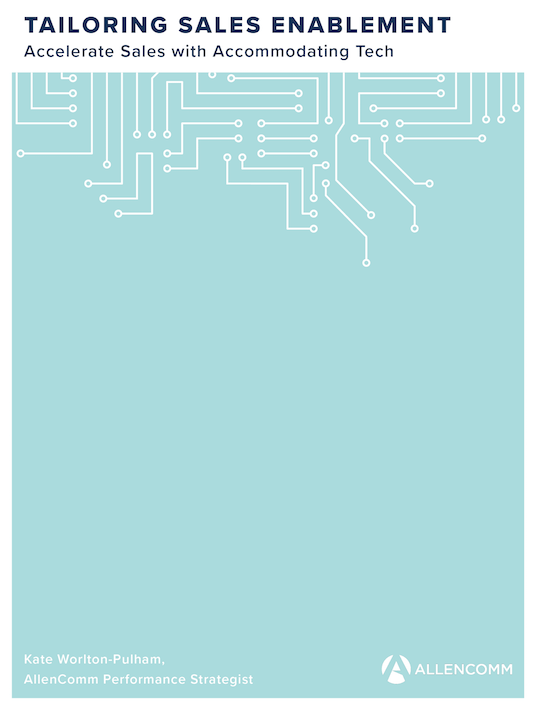Creating A Successful Sales Enablement Strategy: Analysis Before Analytics
When trying to create an effective sales enablement strategy, analysis and analytics are crucial. The good news is that they’re not not mutually exclusive. Like analytics, a needs analysis relies on hard numbers from data tracking, KPI metrics, consumption rates, asset usage, and so forth in order to compile recommendations based on empirical research.

However, while a needs analysis is data-driven, it does not dive straight to Machine Learning and AI because sales enablement must first evaluate the data within the multi-faceted and human context of the organization. The analysis should serve as the sales enablement launch pad, because analytics has its best chance after the needs analysis recommendations have been executed.
Needs Analysis Accelerates Sales
Maximizing sales enablement means accelerating ramp-up time, enriching buyer engagement, and thereby increasing competitive win rates. These are all performance-based, so the strategy first needs to map performance. Any other solution—analytics or otherwise—established before a needs analysis may be misguided and may miss opportunities that are unique to the organization.
A tailored needs analysis as the first step produces a tailored sales enablement strategy. A needs analysis will tell the story of why people need what they need, why they use what they use, and equally why they don’t use or need certain insights. A needs analysis dissects the organization’s productivity, metrics, skill development, asset usage, asset redundancy, training relevance, competency, and so forth. It then knits that matrix of performance information together into a solution calculated to upsurge the organization’s revenue.
Consider the benefits of an early sales enablement needs analysis versus jumping straight into a ready-made sales enablement platform.
1. Customer Value-Based Vs. Product-Based
The needs analysis strategy studies the needed customer impact in terms of the customer’s challenges, strengths, potential, projections, sightlines, and culture. This solidifies existing value and reveals many otherwise unseen opportunities. Conversely, the gates shut early for a solution focused only on a product.
2. Highest-Impact, Tailored Content Vs. The Best Of What’s Available
A needs analysis will recommend and produce only purposeful, made-to-measure assets, tech, and training. Otherwise, sellers have to make do with generic content that doesn’t meet their individualized needs.
3. Recommendations Vs. Undirected Searching
The needs analysis recommends to sellers how and when to use directed content, rather than providing the sellers with a pool of content through which to wade in search of an asset they hope might benefit the buyer.
4. Conversations Vs. Speculations
An organizational performance strategist can design the sales win pathway based on live conversations with focus groups, stakeholders, and team members regarding on-the-job experiences, actions, reactions, thoughts, patterns, and affiliations. The shades of information gleaned from a needs analysis conversation become the shades of information in the strategy. The conversations then can become fruitful, value-based interactions to design the right sales enablement KPI strategy. Otherwise, the solution would rely only on guesswork.
5. Specificity Vs. Assumption
With an analysis, sellers can meet the specific needs of a particular client in the present and anticipate the client’s needs in the future. Without this analysis, organizations can only align with past experience in the wider industry, risking not only generic and non-competitive strategies but also the hidden dangers of assuming that past solutions for others are the right solution for them.
6. Desired Behavior Change Content Vs. All-Purpose Content
Fueled by research and analysis, content is designed for real-time, desired behavior change and performance improvement, rather than content that is potentially outdated, all-purpose, and/or speculative.
Competitive Advantage Unbridled
In sum, a needs analysis for your organization alone is meant to prevent off-the-shelf content, be it training, technology, or assets. It’s meant to tailor content for you to use to your strategic advantage because it is unique to your needs, whereas off-the-shelf assets unify the playing field and nullify your strengths.
Having a needs analysis to tailor your sales enablement strategy will increase your competitive advantage because it teases out hidden opportunities, diagnoses your drawbacks, and shifts both toward enhancing your strengths. It should be stressed that a sales enablement needs analysis is not intended to create a new sales process or change an existing sales process, but rather is intended to augment what works for you. In short, this kind of needs analysis works with you. It doesn’t force an external system with external expectations on you.
Incite A Tailored Strategy For Sales Enablement
A sales enablement strategy needs to allow for a flexible combination of requirements. This is why it must be tailored. Maybe a client needs diagnose their tech and training; perhaps another client needs training and assets, but is happy with their tech; another possibly needs curation with assets and tech, with a redesign of their training. Our experiences confirm that the design that yields the greatest sales acceleration is a combination of all three. No matter what a client’s current sales enablement situation, the step toward greater revenue begins with a needs analysis, then a personalized execution of training, incorporated with the client’s optimal method for asset management and technology.
Reverse Engineer To Revenue
To gain executive buy-in for a needs analysis sales enablement strategy, reverse engineer from the needs analysis to increased revenue for your organization. First, articulate your organization’s needed business impact and KPIs, then the strategy that will filter to that impact. Next, articulate the capabilities that will facilitate that strategy. Finally, articulate that a needs analysis will define the capabilities that are right for you, your stakeholders, your buyers, and their stakeholders.
A Needs Analysis To Transform The Whole Organization
A sales enablement solution is not a patch job or a quick fix on a broken piece or two. It’s an adjunct partnership between a needs analysis provider and the sales organization who have a shared desire to accelerate a sales machine already in motion. The process of a needs analysis establishes a twin investment in a successful strategy that will transform the organization, not just mend some of its sales and marketing parts.

Doing a sales enablement needs analysis first sets the organization up for previously unanticipated revenue opportunities because it delves into the heart of what the people of the organization can accomplish, leverages their talents, trains according to talent differentials, secures only those assets that drive revenue, accommodates them with the right technology, and, ultimately, predicts unforeseen buyer wins.
If you want to learn more about creating a successful sales enablement strategy, download the eBook Tailoring Sales Enablement: Accelerate Sales With Accommodating Tech.








